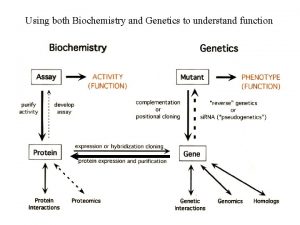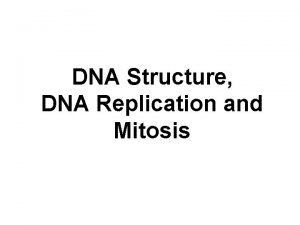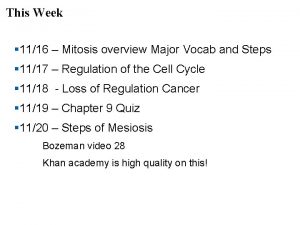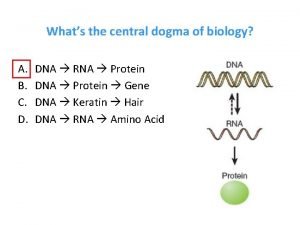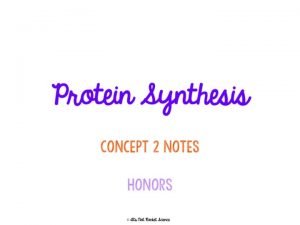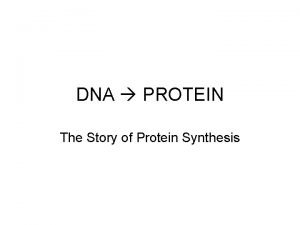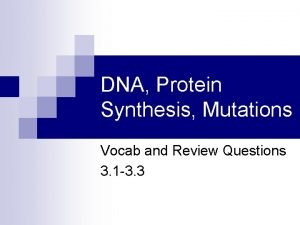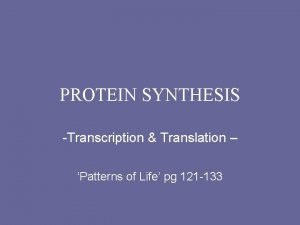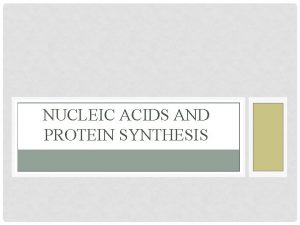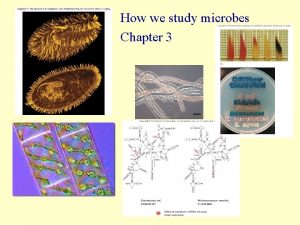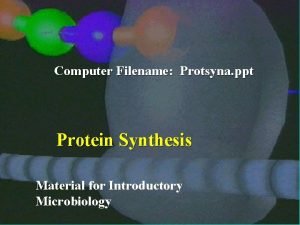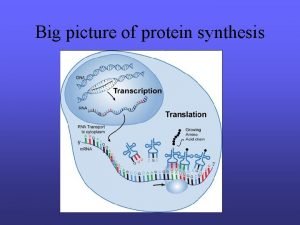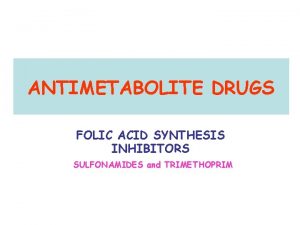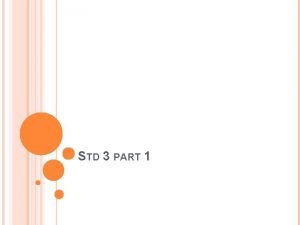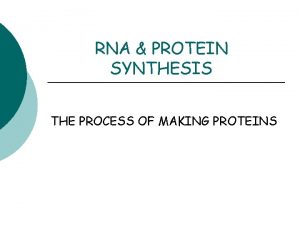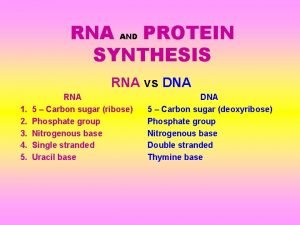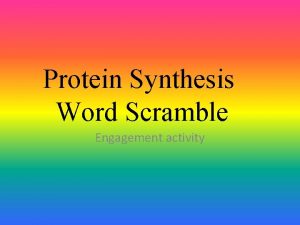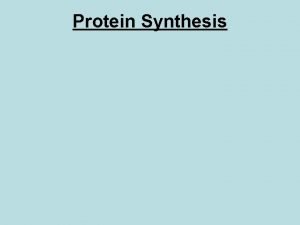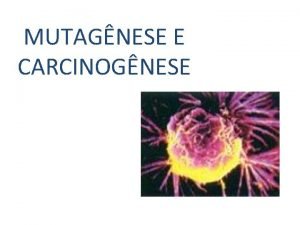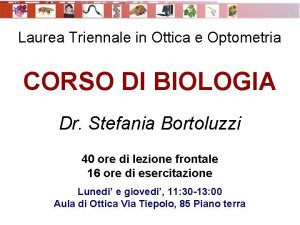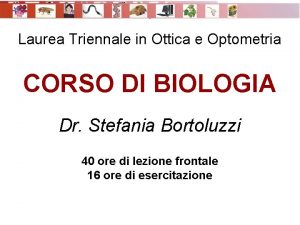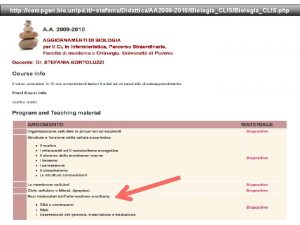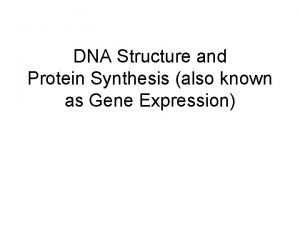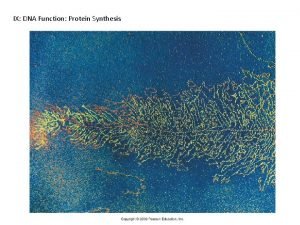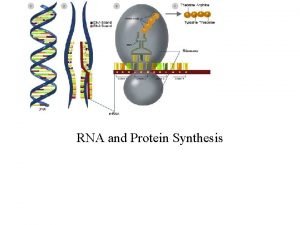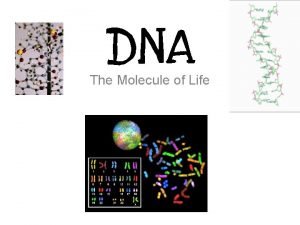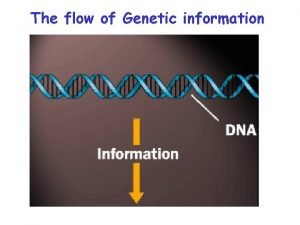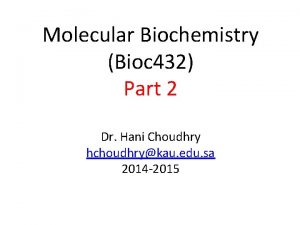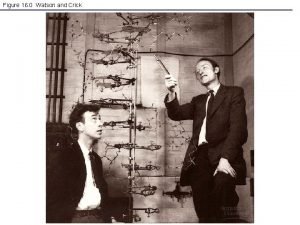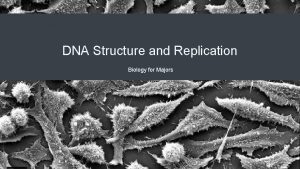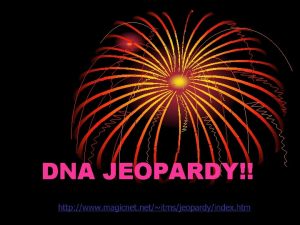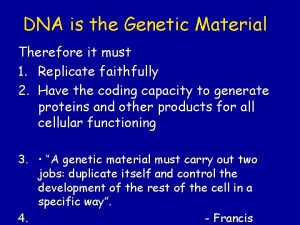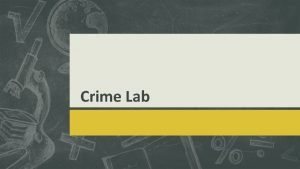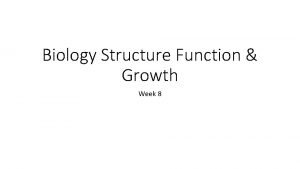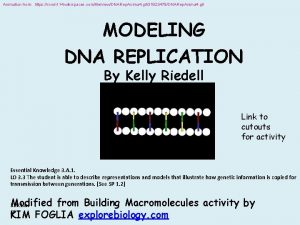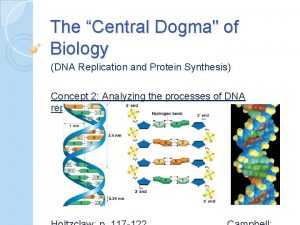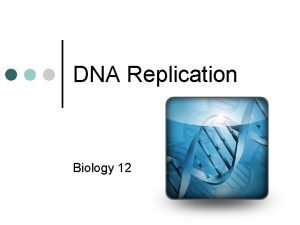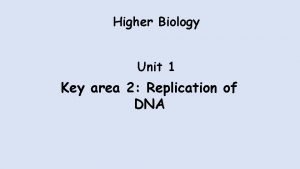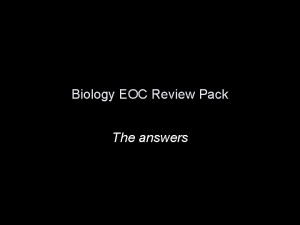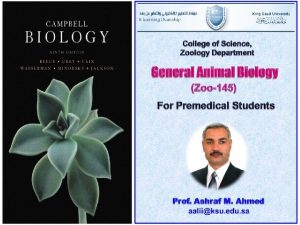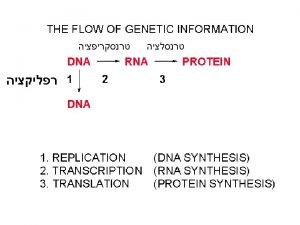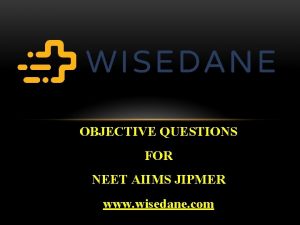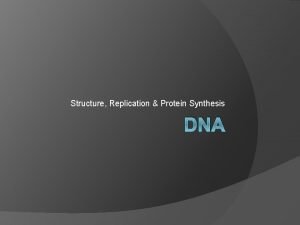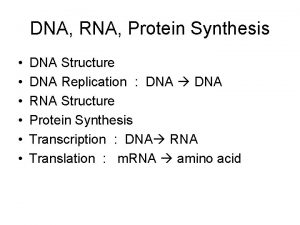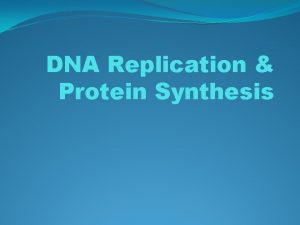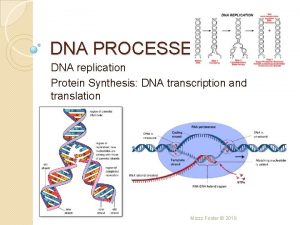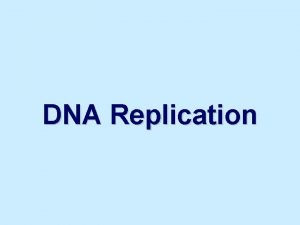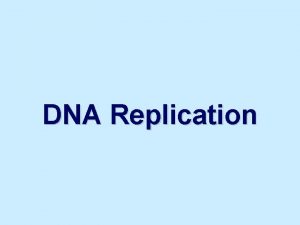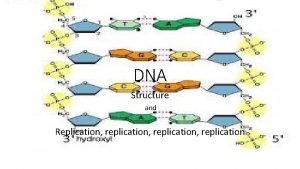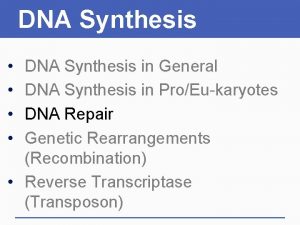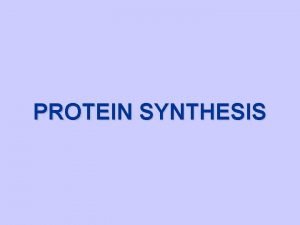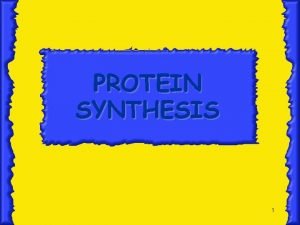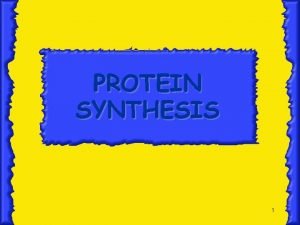DNA Structure DNA Replication Mitosis Protein Synthesis Week


































































- Slides: 66

DNA Structure, DNA Replication, Mitosis, Protein Synthesis Week 8

9/29 DNA Replication 11. 1 Obj. TSW demonstrate base pairing rules of DNA Replication by constructing a 2 -D model of DNA with paper. P. 68 NB Replication Video 1. What is DNA replication? 2. Why does DNA replicate? 3. Diagram the of DNA being replicated HW CH 11 1 page Notes P. 65 NB Show video DNA Replication

#1. Replication of DNA Before a cell can divide by mitosis or meiosis, it must first make a copy of its chromosomes. The DNA in the chromosomes is copied in a process called DNA replication. Without DNA replication, new cells would have only half the DNA of their parents.

DNA Replication of DNA Replication

DNA Replication • DNA replication: the DNA in chromosomes is copied in this process • If I say a strand contains: AATTCC on one side, what will the complementary strand be? You can predict what the bases will be on the other side! Part of replication uses this logic. • During DNA replication, each strand serves as a pattern, or template, to make a new DNA strand.

#3. Steps of DNA Replication STEP 1. Separation of Strands: When a cell begins to copy DNA, the DNA unwinds, and the hydrogen bonds are broken. This allows the bases of nucleotides to be exposed. • Unwinding! • Hydrogen bonds broken! (like unzipping!) STEP 2. A new Sugar- Phosphate backbone forms along the new strand forms.

DNA Replication 3’ to 5’ RULE DNA strands go from 3’ to 5’ or 5’ to 3’ - When DNA strands pair, it is opposite STEP 3. Base pairing: Free nucleotides pair with the exposed DNA bases. STEP 4. Two molecules of DNA are Formed; each is half original & Half complementary.

Semi-conservative Replication p. 65 NB Half of the DNA is Original the other half is new (Complementary)

• DNA Replication Practice p. 65 NB Directions: Using one half of 5. GAT GAA TAC CCA CGA the a DNA helix, show what the correct pairing would be, skip lines in your NB. 1. ATT CGT TAC CTC 2. TAT TAG GCA ATA TTC 3. GTG TGA TTA ATA GCC 4. CTA AAG GAA TAG GAT 6. TAA TAT GCA CAT TAC 7. GAA CCT TAC GGG GTG 8. TAT AAC CAG GAG TTT 9. ATC CGT AGT GTA AAT 10. GGA TTA CCC TTA CCA

DNA Replication Lab p. 67 NB Materials: Scissors, tape, DNA template (on white piece of paper), blank white piece of paper, 4 of each nitrogenous bases (each one different color of paper). Procedures: 1. 2. Pair up with a partner Get supplies: 2 Original Strands of DNA backbone (White), & 1 paper of 4 of each of the Nitrogen Bases 3. 4. 5. 6. Base pair the nitrogen bases to the Deoxyribose sugar. 7. 8. Cut your Original Strand in ½, and base pair the complementary strand to it. Draw your Hydrogen Bonds A=T; C=G Write Original Strand on the two white DNA Backbones. After Mc. Allister reviews your model, she will give you 2 Yellow Backbones that are the complementary strands to base pair your Original strand to. When you have finished your model, answer the questions below in your notebook P. 47 NB Questions: 1. 2. 3. 4. List the 3 functional groups & the 4 nitrogenous bases found in DNA. List the rules for base pairing in DNA. What are the two main functions of DNA? Draw DNA Replication with two different colors.

DNA Replication Activity Tape your Replicated DNA p. 67 NB 1. What is Semi–Conservative Replication? 2. What are the two main functions of DNA? 3. Why is DNA Replication important? 4. List the 3 functional groups & the 4 nitrogenous bases found in DNA. 5. Draw DNA Replication with two different colors. 6. List the rules for base pairing in DNA.

9/29 Cell Growth & Reproduction: Mitosis CH 8. 2 Obj. TSW understand the cell cycle and processes at each stage. P. 68 NB 1. What is mitosis? 2. Draw the Cell Cycle. 3. What is the result of Mitosis?

Problem Solving Lab 8. 2 P. 204 BB Read the Observe & Infer section. p. 69 NB • • Read the Solve the Problem. • Answer the three “Thinking Critically” questions p. 61 NB 1. Growth 1 phase- Rapid Growth & metabolism of Interphase is the most variable in length. 2. The two types of cells have different functions and one is more complex than the other. 3. The cycle of some types of cells is faster then others because of the complexity of the proteins made by the cell or the need to produce cells due to rapid wear and tear – like skin cells compared to muscles cells or nerve cells in the spine (do not regenerate).

Mitosis Practice p. 65 NB Get 2 white boards/ lab station Get 1 Expo marker / 2 students Draw a nucleus and place your replicated chromosomes inside the nucleus. • With the yellow and red chromosomes, practice the 4 stages of Mitosis, drawing and erasing the nucleus as the stages dictate. • After you show them to me/us, Then draw the phases of Mitosis on page 63 NB.

Mitosis Rules p. 65 NB • Create a Mental model of how a cell cycle works that shows an end result of 2 identical cells after Mitosis with the same number of chromosomes. • Set up rules for what a cell can and can not do. • What steps does the cell have to go through to create two new identical cells. • Result of Mitosis: 2 identical cells with the same # of chromosomes that make tissues, that form organs, that are part of an organ system and make an organism.

10/3 RNA (Ribonucleic Acid) CH 11. 2 Obj. TSW compare and contrast the structure and function of DNA and RNA in the Warm Up, and from the video. P. 72 NB 1. Describe how RNA’s structure differs from DNA’s structure in three ways? 2. Identify and describe the functions of the three types of RNA. 3. What is the main difference between Transcription and DNA Replication? Study for DNA Quiz: CH 11 Tuesday Work on your Lab – Final Lab due Friday

Science Article: Endosymbiotic Theory p. 65 NB • • • Read the article quietly. Read the article out loud. Pair up and write the Claim, Evidence and Reasoning Discuss as a class: Endosymbiotic Theory Turn the Paper over and write the AXES Paragraph on Endosymbiotic Theory

#1. RNA like DNA, is a nucleic acid. RNA structure differs from DNA structure in three ways. First, RNA is single stranded—it looks like one-half of a zipper —whereas DNA is double stranded.

#1. Transcription To return to the chapter summary click escape or close this document.

#1. RNA Both DNA and RNA contain four nitrogenous bases, but rather than thymine, RNA contains a similar base called uracil (U). Uracil forms a base pair with adenine in RNA, just as thymine does in DNA. Uracil Hydrogen bonds Adenine

#1. Second: Chemical Difference of DNA and RNA Uracil is the Nitrogen base that replaces Thymine To return to the chapter summary click escape or close this document.

#1. RNA Third: The sugar in RNA is Ribose; DNA’s sugar is deoxyribose. Ribose

#2. RNA Transfer RNA (t. RNA) is the supplier. Transfer RNA delivers amino acids to the ribosome to be assembled into a protein. Click image to view movie

#2. RNA There are three types of RNA that help build proteins. Messenger RNA (m. RNA), brings instructions from DNA in the nucleus to the cell’s factory floor, the cytoplasm. On the factory floor, m. RNA moves to the assembly line, a ribosome.

Protein Synthesis – Monday!!!!! 10/3 • • • 1 large bag of M & M’s – 1 large bag of Gummy Bears – 4 bags of Marshmallows 1 stick of Butter – Mc. Allister 1 box Rice Krispy Cereal -

DNA Quiz Thursday 10/5 1 piece of Binder Paper & pencil or pen. Write your name on the top right hand side. 1. What is the name of the molecule that holds our genetic information? 2. What is the shape of that molecule? 3. Where is that molecule located in the cell? 4. What are the 4 Nitrogen Bases that code for Amino Acids? 5. Write how the Nitrogen base pair together. 6. What is the bond that holds the nitrogen bases together? 7. Draw & Write three parts of a nucleotide. 8. What is DNA Replication? 9. What are the two functions of DNA? 10. How is RNA different from DNA?

Genes Expression = Proteins You learned earlier that proteins are polymers of amino acids. The sequence of nucleotides in each gene contains information for assembling the string of amino acids that make up a single protein.

#2. RNA The ribosome, made of ribosomal RNA (r. RNA), binds to the m. RNA and uses the instructions to assemble the amino acids in the correct order.

What Process is this? What are the steps? What is the name for this particular type of process? To return to the chapter summary click escape or close this document.

#3. The difference of DNA Replication & Transcription – first process of Transcription (Making Proteins) making proteins. DNA Replication – makes more DNA for more cells.


Record Book Time!!! We love theaet. com CA 0577 • Objective: By Wednesday October 11 th, I have everyone’s SAE Agreement. 20 points. 1. Log on: Explore AET. com if you don’t know what your SAE is yet to help you make a decision. Also talk to Mc. Allister. 2. Log on: theaet. com if you know your SAE to get started entering your description, time, objectives, finances. Please always write in complete sentences, this will be part of your agreement, signed by me and your parents. 1. Click Profile, Your Activities Experience Manager SAE(Add New) Enter you Description, Time, Finances, and Learning Objective 2. When you are done entering all your information for your SAE, Click on the Blue “PDF Agreement”& read it. Edit what you need. Tell me to Print, Take Home and get signed. 3. Don’t forget your PICTURES!!!! Load them into your Project.

10/4 Protein Synthesis: Transcription 11. 2 Week 8 Obj. TSW be able to explain the process of Transcription by making m. RNA strand from DNA through practice. P. 74 NB Learn. genetics. utah. edu/ 1. What is transcription? 2. Where does Transcription happen? 3. Why is a codon important to making a protein?

Cracking the Code • Answer the Questions on the ½ sheet of paper

Transcription In the nucleus, enzymes make an RNA copy of a portion of a DNA strand in a process called transcription. Click image to view movie

Transcription A DNA strand RNA strand C B DNA strand

Transcription The main difference between transcription and DNA replication is that transcription results in the formation of one single-stranded RNA molecule rather than a double-stranded DNA molecule.

RNA Processing = Gene Expression Not all the nucleotides in the DNA of eukaryotic cells carry instructions—or code—for making proteins. Genes usually contain many long noncoding nucleotide sequences, called introns, that are scattered among the coding sequences.

Question 1 How does DNA control the structures and functions of a cell? Answer DNA determines the structure of proteins. Some proteins become important cell structures. Other proteins, such as enzymes, control chemical reactions that perform key life functions. CA: Biology/Life Sciences 5 a

1. Deoxyribose 9. *Nucleotides CH 11 DNA &10. Genes p. 41 2. HW Nitrogenous Base DNA Replication 3. Nucleotide 11. Double Helix 4. Base Pair 5. Hydrogen Bond 6. Phosphate 7. Adenine (A) & Nitrogen Bases 8. Cytosine NB

HW CH 11 DNA &Genes* 1. 2. 3. 4. 5. 6. 7. 8. DNA – Double RNA – single DNA – Deoxyribose RNA – Ribose DNA – ATCG RNA – AUCG Amino Acids Proteins Codon* Threonine

QUIZ 8. What is DNA Replication? 9. What are the two functions of DNA? 10. What are three differences of RNA from DNA? 11. What RNA has stop codons, and what is their function? 12. How are codons and anticodons different? 13. Write the equation for Protein Synthesis. 14. Transcribe & Translate the DNA sequence: ATC, TCA, TAC

DNA Quiz 7. What is the backbone of the molecule made of? 8. What is a gene? 9. What does DNA code for? What is it’s purpose? 10. Write the formula for Protein Synthesis When you are finished turn you paper upside down and wait quietly to have me pick it up.

POP QUIZ Write your name on your binder paper. 1. What is this molecule? Spell it out. 2. What is the shape of the molecule? 3. What are the two purposes/ functions of this molecule? 4. Write three names for the parts of a nucleotide. Be specific. 5. The Nitrogen bases are: Adenine, Cytosine, Guanine, & Thymine – Base Pair them together correctly. 6. What holds the Nitrogen bases together? 7. DNA is a Nucleic Acid, write an example of another one. 8. Can a Nucleic Acid leave the nucleus? 9. What is DNA Replication? 10. What is the name for how DNA Replications?

Question 2 The process through which the order of bases in messenger RNA codes for the order of amino acids in a protein is: A. transcription B. translation C. replication D. point mutation The answer is B. CA: Biology/Life Sciences 4 f

Question 3 Why would scientists use nucleotide sequences to identify bodies of crime victims? Answer In comparing nucleotide sequences in the DNA of a crime victim with nucleotide sequences from a possible close relative of the crime victim, scientists can determine if the two are related. CA: Biology/Life Sciences 4 e

HW CH 11 9. Phenylalanine Codon are (UUU) (UUC) 10. Codon 11. Amino Acid 12. Amino Acid 13. Stop codons = UGA, UAG, UAA 14. Tryptophan & Methionine

Making RNA p. 71 NB • Backbone= Phosphate & Sugar (Red & White) • Nitrogen Bases= Adenine (Blue)=Thymine (Green) Cytosine (Yellow )=-Guanine (Orange) Uracil (Pink) RNA • Hydrogen bond (clear barbell) • http: //learn. genetics. utah. edu/ WS - DNA Model Discussion questions P. 71 NB 1. How is RNA different from DNA, Name 3 ways. 2. What Nitrogen base replaces Thymine in RNA?

10/5 Protein Synthesis: Translation 11. 2 Obj. TSW explain the process of Protein Synthesis by working on their Protein Synthesis foldable and transcribing and translating DNA sequences from their Mini Lab 11. 1 P. 76 NB Learn. genetics. utah. com. edu/ 1. Compare & Contrast Codon and Anticodon. 2. What is the role of t. RNA in Protein Synthesis? 3. Why are Stop Codons important in Translation? http: //www. dnatube. com/video/3448/DNAReplication

#1. Codon & Anticodon • A Codon is a nucleotide triplet sequence on m. RNA, it codes for an amino acid. • AUG ACG GAG • An Anticodon is a nucleotide triplet sequence on t. RNA that carries the Amino acid • UAC • Both are RNA & Each triplet pairs to code for a particular Amino acid to form a protein.

#2. The role of transfer RNA - t. RNA As translation begins, a ribosome attaches to the starting end of the m. RNA strand. Then, t. RNA molecules, each carrying a specific amino acid, approach the ribosome. When a t. RNA anticodon pairs with the first m. RNA codon, the two molecules temporarily join together. Usually, the first codon on m. RNA is AUG, which codes for the amino acid methionine.

#3. Stop Codons • Without the stop codon, the protein would continuously be made. • More Protein is not necessarily better. • Name the 3 codons for STOP: • UAA, UAG, UGA

The Genetic Code P. 292 BB The Messenger RNA Genetic Code First Letter U C A G Second Letter U A G Serine (UCU) Tyrosine (UAU) Phenylalanine (UUC) Serine (UCC) Tyrosine (UAC) Cysteine (UGU) Cysteine (UGC) Leucine (UUA) Leucine (UUG) Serine (UCA) Stop (UAA) Stop (UGA) Serine (UCG) Stop (UAG) Tryptophan (UGG) Leucine (CUU) Histadine (CAU) Arginine (CGU) Leucine (CUC) Proline (CCU) Proline (CCC) Histadine (CAC) Arginine (CGC) Leucine (CUA) Proline (CCA) Glutamine (CAA) Arginine (CGA) Leucine (CUG) Isoleucine (AUU) Proline (CCG) Threonine (ACU) Glutamine (CAG) Arginine (CGG) Asparagine (AAU) Serine (AGU) Isoleucine (AUC) Isoleucine (AUA) Methionine; Start (AUG) Threonine (ACC) Threonine (ACA) Threonine (ACG) Asparagine (AAC) Serine (AGC) Lysine (AAA) Lysine (AAG) Arginine (AGA) Arginine (AGG) Valine (GUU) Alanine (GCU) Aspartate (GAU) Glycine (GGU) Valine (GUC) Alanine (GCC) Aspartate (GAC) Glycine (GGC) Valine (GUA) Valine (GUG) Alanine (GCA) Alanine (GCG) Glutamate (GAA) Glutamate (GAG) Glycine (GGA) Glycine (GGG) Phenylalanine (UUU) C Third Letter U C A G

10/9 Protein Synthesis: Translation 11. 2 Obj. TSW explain the process of Protein Synthesis by diagramming all the steps in their notebook. P. 78 NB 1. When making proteins, If a template Learn. genetics. utah. edu/ DNA strand read TAC GGT, AGT what would a complementary strand of m. RNA be? 2. What Amino Acids would the 3 codons code for? 3. Do the same for: GCA, TGC, ATC (DNA).

Protein Synthesis p. 59 NB DNA -> transcription -> RNA -> translation -> Proteins

Mini Lab 11. 1 P. 67 NB P. 293 BB DNA transcription RNA translation Protein • Copy this table in your notebook. A DNA Base Process Sequence AAT GGG ATA AAA GTT B C D E m. RNA Codon Process t. RNA Amino Acid Anticodon

Mini Lab 11. 1 P. 67 NB P. 293 BB DNA transcription RNA translation Protein A B C D E DNA Base Process Sequence m. RNA Codon Process t. RNA Anticodon Amino Acid AAT UUA Translation AAU Leucine Transcription GGG CCC GGG Proline ATA UAU AUA Tyrosine AAA UUU AAA Phenylalanine GTT CAA GUU Glutamine Answer Analysis Questions 1 – 3 1. A. DNA instructions are located in the nucleus. b. Transcription happens in the nucleus. c. Translation happens in the Ribosome. 2. t. RNA looks like a triangle with an Amino Acid on the end, and the other side has the Anticodon that base pairs with the codon on the m. RNA. 3. Mutations would be more common, if the sequence of DNA was not strictly adhered

Page 292 Biology Book

Molecular Genetics p. 69 NB DNA Replication – make more DNA for more cells to replace other cells. DNA-DNA A = T T = A C = G Protein Synthesis – to make proteins DNA RNA A = U T = A C = G G = C Protein Synthesis DNA: TAC CAC AAC Transcription (nucleus) m. RNA: AUG GUG UUG Translation (ribosome) Protein: Methionine, ________ Amino Acid Sequence

Protein Synthesis Transcription Practice p. 69 NB • Directions: Using the DNA 5. GAT GAA TAC CCA CGA strand as a template, 6. TAA TAT GCA CAT TAC transcribe m. RNA. Make sure 7. GAA CCT TAC GGG GTG to use the correct Nitrogen bases. 8. TAT AAC CAG GAG TTT 1. ATA CCT TAA CGC GTC 9. ATC CGT AGT GTA AAT 2. TAT TAG GCA AAA TTC 10. GGA TTA CCC TTA CCA 3. GTG TGA TTA ATA GCC 4. CTA AAG GAA TAG GAT


Protein Synthesis – Gene Expression 1. DNA: ATA CCT TAA CGC GTC 2. DNA: TAT TAG GCA AAA TTC

AXES Paragraph P. 71 NB • Write a paragraph after building your DNA molecule that include the vocabulary words: Double helix, Nitrogen bases, Hydrogen bond, Nucleotide, Backbone, Deoxyribose, Phosphate, Adenine, Thymine, Cytosine, Guanine.

Collect 3 sheets of paper and layer them about 1. 5 cm apart vertically. Keep the edges level. P. 53 NB To return to the chapter summary click escape or close this document.

Fold up the bottom edges of the paper to form 6 equal tabs. P. 53 NB To return to the chapter summary click escape or close this document.

Fold the papers and crease well to hold the tabs in place. Staple along the fold. Label P. each tab. 53 NB RNA – draw & label 3 differences from DNA 289 TRANSCRIPTION: from DNA to RNA P. 290 RNA Processing (Introns & Exons) p. P. 291 The Genetic Code p. 291 - 292 TRANSLATION: from m. RNA to PROTEIN 11. 9 A p. 294 PROTEIN SYNTHESIS DNA->transcription->RNA ->translation->Protein To return to the chapter summary click escape or close this document.
 Chapter 11 dna and genes
Chapter 11 dna and genes Bioflix activity dna replication nucleotide pairing
Bioflix activity dna replication nucleotide pairing Dna synthesis at replication fork
Dna synthesis at replication fork Rna and protein synthesis study guide
Rna and protein synthesis study guide Function of dna polymerase 3
Function of dna polymerase 3 Dna structure and replication pogil
Dna structure and replication pogil Dna structure and replication packet answer key
Dna structure and replication packet answer key Nature of dna replication
Nature of dna replication Handwriting คือ
Handwriting คือ Rna protein synthesis
Rna protein synthesis Section 12 3 rna and protein synthesis answers
Section 12 3 rna and protein synthesis answers Order of bases in dna
Order of bases in dna Cell analogy restaurant
Cell analogy restaurant Translation or transcription
Translation or transcription Protein synthesis bbc bitesize
Protein synthesis bbc bitesize Protein synthesis and mutations
Protein synthesis and mutations Dna cookbook analogy
Dna cookbook analogy Guac wheel biology
Guac wheel biology Protein synthesis
Protein synthesis Protein synthesis
Protein synthesis Protein synthesis
Protein synthesis Protein synthesis and mutations
Protein synthesis and mutations Synthesis
Synthesis Protein synthesis and mutations
Protein synthesis and mutations Protein synthesis animation mcgraw hill
Protein synthesis animation mcgraw hill Molecular genetics and biotechnology
Molecular genetics and biotechnology Translation protein synthesis
Translation protein synthesis Ribonucleic acid
Ribonucleic acid Ribosome
Ribosome Protein synthesis ppt
Protein synthesis ppt Picture of protein synthesis
Picture of protein synthesis Protein synthesis inhibitor
Protein synthesis inhibitor Which best summarizes the process of protein synthesis?
Which best summarizes the process of protein synthesis? Concept map of protein synthesis
Concept map of protein synthesis Protein synthesis
Protein synthesis Protein synthesis scramble
Protein synthesis scramble Steps of protein synthesis
Steps of protein synthesis Protein synthesis
Protein synthesis Teste de ames
Teste de ames Protein synthesis
Protein synthesis Protein synthesis
Protein synthesis Protein synthesis
Protein synthesis Protein synthesis
Protein synthesis Catalytic functions
Catalytic functions Comparing dna and rna worksheet answers
Comparing dna and rna worksheet answers Rna transfer
Rna transfer Channel vs carrier proteins
Channel vs carrier proteins Protein-protein docking
Protein-protein docking Dna stand for
Dna stand for Dna replication is semi-conservative
Dna replication is semi-conservative Okazaki fragments
Okazaki fragments 3 models of dna replication
3 models of dna replication Major enzymes in dna replication
Major enzymes in dna replication Accgtat
Accgtat Dna replication jeopardy
Dna replication jeopardy 3 models of dna replication
3 models of dna replication Missy baker
Missy baker What process is this
What process is this Nucleoside triphosphate in dna replication
Nucleoside triphosphate in dna replication Bioflix dna replication
Bioflix dna replication Dna replication fork
Dna replication fork Dna replication transcription and translation
Dna replication transcription and translation Dna replication higher human biology
Dna replication higher human biology Why is dna replication considered semiconservative
Why is dna replication considered semiconservative Dna replication pearson
Dna replication pearson Direction of helicase
Direction of helicase Dna replication in bacteria occurs
Dna replication in bacteria occurs


